 | |
| Author | Carl Sargent |
|---|---|
| Genre | Role-playing game |
| Publisher | TSR |
Publication date | 1989 |
Top Ballista is an accessory for the Dungeons & Dragons fantasy role-playing game.
 | |
| Author | Carl Sargent |
|---|---|
| Genre | Role-playing game |
| Publisher | TSR |
Publication date | 1989 |
Top Ballista is an accessory for the Dungeons & Dragons fantasy role-playing game.
Top Ballista is a supplement for a campaign setting in the city of Serraine, populated by the magical biplane-piloting skygnomes, and presents rules to create player characters (PCs) of skygnomes and other races. [1]
The aerial city of Serraine flies over the Known World carrying its skygnome inhabitants, creators of bizarre yet workable inventions. The book describes the flying aces of the Top Ballista squadrons, gnomes who pilot flying machines, World War I style fighter planes, equipped with lightning guns and synchronized crossbows. [2] Creatures featured in the product, all living in Serraine, are faenare (birdmen able to create spell-like effects through songs), gnomes, gremlins, harpies, nagpa (vulture-headed humanoids), pegataurs (winged centaurs), sphinxes, and tabi (catlike creatures). [2] Each of these races is introduced by a character who describes their cultures, evolution, and lifestyles. Some creatures start with negative experience points totals when used as PCs. [2]
There are three adventures for characters of various experience point levels. The first contains a basilisk that must be defeated by the PCs. The longest adventure is for characters of levels 7–11, and is set within the flying city. The opening stages require a fair bit of detective work from the PCs, and after the investigation in the city, the PCs chase the villain through the air in one of the planes. [2]
PC2 Top Ballista was written by Carl Sargent and published by TSR in 1989. [1] The package included a sixty-four page booklet, a thirty-two page adventure booklet, a full-color map of the city, and a two-panel card cover. [2] Editing was by Jennell Jaquays [lower-alpha 1] , with cover and interior illustrations by John Lakey. [2]
Jim Bambra reviewed Top Ballista for Dragon magazine #164 (December 1990). [2] He felt that the text describing the races of Serraine is "presented in a cheerful and illuminating manner that captures the flavor of the city and its inhabitants nicely". [2] Bambra examined the product's game mechanics and found numerous flaws which "ruin what is in many ways a fine product", with the mechanics "showing signs of not having been designed or edited very thoroughly", and while he felt that some areas are "markedly better than others", Bambra concluded that "I found enough mistakes and poorly considered areas to give me cause for concern". [2] He pointed out the poorly balanced character level advancement (with nagpa and sphinx PCs in particular progressing very slowly compared to other characters), inconsistencies between tables and references in the text, redundant charm abilities for harpies, and other problems. Despite this, he felt the sky gnomes and their ability to build machines using fantasy physics are handled well, called the faenare "a finely detailed race with nifty powers", complimented the city as "neatly described", and said, "the plane rules look like they'll work". [2] He felt that the visual presentation is of high quality, calling the illustrations of the four planes "excellent", and noting that the interior artwork "captures the humorous flavor of the product well", although he added that some of the races had no illustrations, pointing out that the single nagpa illustration is not near its entry. [2] Bambra concluded by saying: "Top Ballista suffers from a large number of design flaws, which is a pity as it has some great ideas and well-written descriptive passages. The background sections are generally very good, making it a fun and unusual adventure setting. Viewed as a source of background information, Top Ballista is useful, but its failure to provide balanced PC creatures weakens it greatly. This one is for completists only." [2]

Dungeonland (EX1) is a 1983 adventure module for the Dungeons & Dragons (D&D) roleplaying game, written by Gary Gygax for use with the First Edition Advanced Dungeons & Dragons (AD&D) rules. It is an adaptation of Lewis Carroll's 1865 novel Alice's Adventures in Wonderland, with the various characters from the book translated into AD&D terms.

Waterdeep and the North is an accessory for the Dungeons & Dragons campaign setting Forgotten Realms. It was written by Ed Greenwood and published by TSR in 1987.
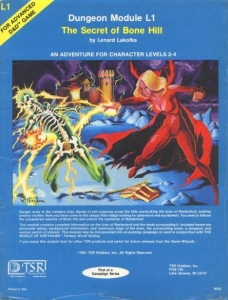
The Secret of Bone Hill is an adventure module written by Lenard Lakofka for the first edition of Advanced Dungeons & Dragons and published by TSR in 1981. It is designed for novice and intermediate players with characters of levels 2-4. The module received mixed reviews from critics.
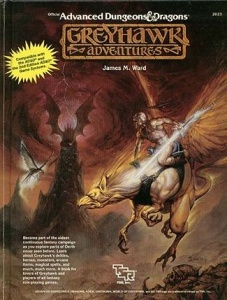
Greyhawk Adventures is an accessory for the Advanced Dungeons & Dragons (AD&D) World of Greyhawk campaign setting.

Descent Into the Depths of the Earth is an adventure module for the Dungeons & Dragons (D&D) fantasy roleplaying game coded D1–2. It was written by Gary Gygax, and combines two previously published modules from 1978, the original Descent into the Depths of the Earth and Shrine of the Kuo-Toa. A sequel to the first two modules, Vault of the Drow, was also published in 1978. All of these D-series modules were produced for use with the 1st edition Advanced Dungeons & Dragons (AD&D) rules.
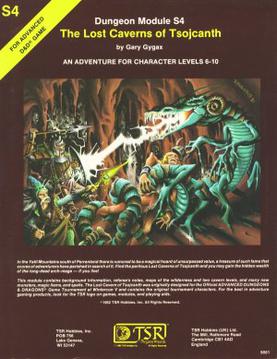
The Lost Caverns of Tsojcanth is an adventure module for the Dungeons & Dragons fantasy role-playing game. It was written by Gary Gygax and published by TSR in 1982 for the first edition Advanced Dungeons & Dragons (AD&D) rules. The 64-page adventure bears the code "S4" and is set in the Greyhawk campaign setting. It is divided into two parts, a 32-page adventure, and a 32-page booklet of monsters and magic items. The plot involves the player characters investigating rumors of lost treasure. After traversing a wilderness and two levels of dungeons, the players face Drelnza, the vampiric daughter of long-deceased archmage Iggwilv.
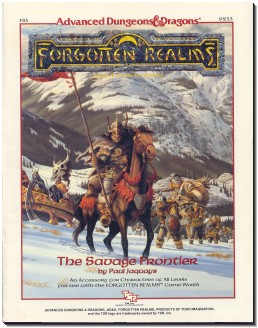
The Savage Frontier is an accessory for the Dungeons & Dragons campaign setting Forgotten Realms. It describes the Savage Frontier of Faerûn. The book was written by Jennell Jaquays and published by TSR in 1988. Cover art is by Larry Elmore, with interior illustrations by Esteban Maroto, and cartography by Dave Sutherland, Dennis Kauth, and Jaquays.
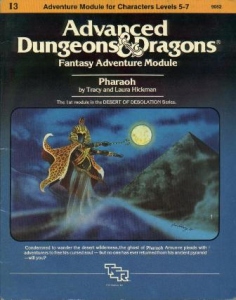
Pharaoh is an adventure module for the Dungeons & Dragons fantasy role-playing game. The module was published in 1982 by TSR, Inc. for the first edition Advanced Dungeons & Dragons rules. It formed the first of the three-part Desert of Desolation module series. The module was written by Tracy and Laura Hickman; Tracy Hickman would later go on to help create the Dragonlance campaign setting.

Desert of Desolation is a compilation adventure module published by TSR for the Dungeons & Dragons (D&D) fantasy roleplaying game. It combines three previously published individual modules: Pharaoh, Oasis of the White Palm, and Lost Tomb of Martek. The modules were made for use with the first edition Advanced Dungeons & Dragons (AD&D) rules. Pharaoh was created by Tracy and Laura Hickman soon after the couple married in 1977, and published by TSR in 1982. Oasis of the White Palm was a collaboration between Tracy Hickman and Philip Meyers, and Hickman wrote the Lost Tomb of Martek on his own; both were printed in 1983.

Night's Dark Terror is an adventure module for the Dungeons & Dragons (D&D) fantasy role-playing game written by British game designers Jim Bambra, Graeme Morris, and Phil Gallagher. It was designed specifically for campaigns transitioning from the D&D Basic Set to the D&D Expert Set. The player characters (PCs) journey from a farmstead into uncharted wilderness, where they encounter new hazards and contend with a secret society. The adventure received a positive review from White Dwarf magazine.
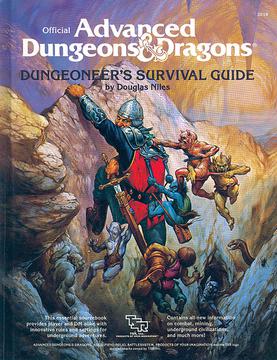
Dungeoneer's Survival Guide is a supplement to the Dungeons & Dragons fantasy role-playing game. The book was written by Douglas Niles, and published by TSR, Inc. in 1986.

Dwellers of the Forbidden City is an adventure module, or pre-packaged adventure booklet, ready for use by Dungeon Masters in the Dungeons & Dragons (D&D) fantasy role-playing game. The adventure was first used as a module for tournament play at the 1980 Origins Game Fair, and was later published by TSR in 1981 for use with the first edition Advanced Dungeons & Dragons rules. The module was written by game designer David "Zeb" Cook, who partly ascribes his hiring by TSR to his work on this module. In the adventure, the characters are hired to find an object taken to a lost oriental-style city, which has been taken over by a cult of snake-worshipers, the yuan-ti, and their servants, the mongrelmen and tasloi.
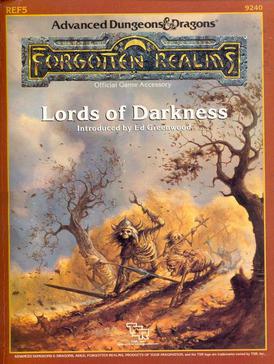
Lords of Darkness is the name of two accessories for the fictional Forgotten Realms campaign setting for the Dungeons & Dragons fantasy role-playing game.

Empires of the Sands is an accessory for the fictional Forgotten Realms campaign setting for the first edition of the Advanced Dungeons & Dragons fantasy role-playing game. The book was published in 1988 and written by Scott Haring, with cover and interior art by Jeff Easley.

Talons of Night is an Egyptian-themed adventure module for the Dungeons & Dragons fantasy role-playing game, set in that game's Mystara campaign setting. TSR, Inc. published the module in 1987 for the D&D Master Set rules. It is part of the "M" series of modules. The module was designed by Jennell Jaquays. Its cover art is by Daniel Horne. Its interior art is by Jennell Jacquays, and cartography by Dennis Kauth and Steve Sullivan.

Bestiary of Dragons and Giants is an accessory for the Dungeons & Dragons fantasy role-playing game, published in 1987 by TSR.

The Orcs of Thar is an accessory for the Dungeons & Dragons fantasy role-playing game, written by Bruce Heard and published by TSR in 1988.
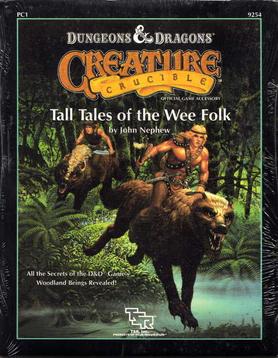
Tall Tales of the Wee Folk is an accessory for the Dungeons & Dragons fantasy role-playing game.

Ents of Fangorn is a supplement published by Iron Crown Enterprises in 1987 for Middle-earth Role Playing (MERP), a fantasy role-playing game based on J.R.R. Tolkien's The Lord of the Rings.
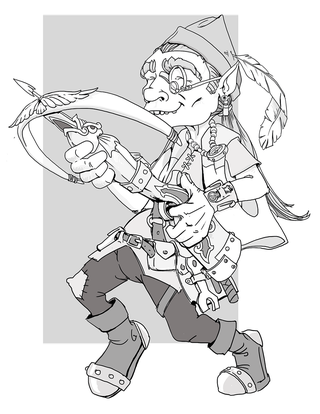
In the Dungeons & Dragons fantasy role-playing game, gnomes are one of the core races available for play as player characters. Some speculate that they are closely related to dwarves; however, gnomes are smaller and more tolerant of other races, nature, and of magic. Depending on the setting and subrace, they are often skilled with illusion magic or engineering. Gnomes are small humanoids, standing 3–3.5 feet (91–107 cm) tall.